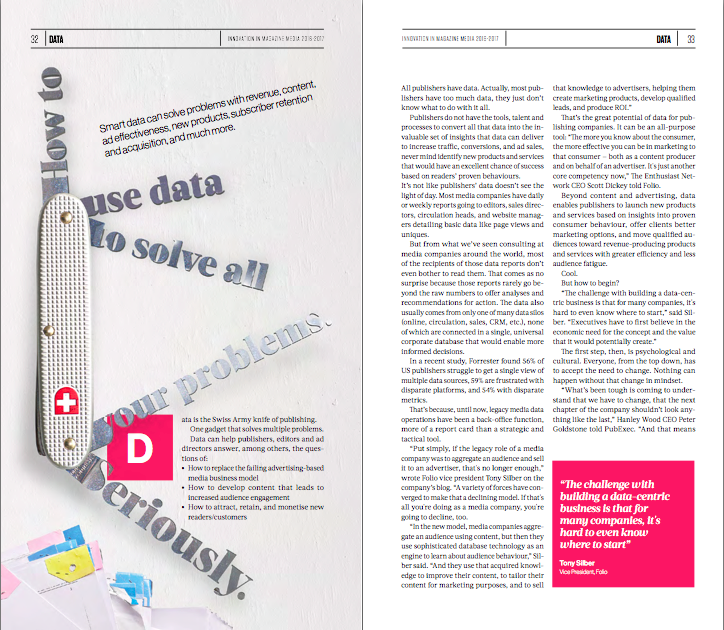
20 Oct How to use data to solve all of your problems
Data is the Swiss Army knife of publishing. One gadget that solves multiple problems.
Data can help publishers, editors and ad directors answer, among others, the questions of:
• How to replace the failing advertising-based media business model
• How to develop content that leads to increased audience engagement
• How to attract, retain, and monetise new readers/customers
All publishers have data. Actually, most publishers have too much data, they just don’t know what to do with it all.
Publishers do not have the tools, talent and processes to convert all that data into the invaluable set of insights that data can deliver to increase traffic, conversions, and ad sales, never mind identify new products and services that would have an excellent chance of success based on readers’ proven behaviours.
It’s not like publishers’ data doesn’t see the light of day. Most media companies have daily or weekly reports going to editors, sales directors, circulation heads, and website managers detailing basic data like page views and uniques.
But from what we’ve seen consulting at media companies around the world, most of the recipients of those data reports don’t even bother to read them. “That comes as no surprise because those reports rarely go beyond the raw numbers to o ffer analyses and recommendations for action. “The data also usually comes from only one of many data silos (online, circulation, sales, CRM, etc.), none of which are connected in a single, universal corporate database that would enable more informed decisions.

In a recent study, Forrester found 56% of US publishers struggle to get a single view of multiple data sources, 59% are frustrated with disparate platforms, and 54% with disparate metrics.
“That’s because, until now, legacy media data operations have been a back-office function, more of a report card than a strategic and tactical tool.
“Put simply, if the legacy role of a media company was to aggregate an audience and sell it to an advertiser, that’s no longer enough,” wrote Folio vice president Tony Silber on the company’s blog.
“A variety of forces have converged to make that a declining model. If that’s all you’re doing as a media company, you’re going to decline, too. In the new model, media companies aggregate an audience using content, but then they use sophisticated database technology as an engine to learn about audience behaviour,” Silber said. “And they use that acquired knowledge to improve their content, to tailor their content for marketing purposes, and to sell that knowledge to advertisers, helping them create marketing products, develop qualified leads, and produce ROI.”
“That’s the great potential of data for publishing companies. It can be an all-purpose tool: “The more you know about the consumer, the more effective you can be in marketing to that consumer — both as a content producer and on behalf of an advertiser. It’s just another core competency now,” Enthusiast Network CEO Scott Dickey told Folio.
Beyond content and advertising, data enables publishers to launch new products and services based on insights into proven consumer behaviour, offer clients better marketing options, and move qualified audiences toward revenue-producing products and services with greater efficiency and less audience fatigue.
Cool.
But how to begin?
“The challenge with building a data-centric business is that for many companies, it’s hard to even know where to start,” said Silber. “Executives have to first believe in the economic need for the concept and the value that it would potentially create.”
The first step, then, is psychological and cultural. Everyone, from the top down, has to accept the need to change. Nothing can happen without that change in mindset.
“What’s been tough is coming to understand that we have to change, that the next chapter of the company shouldn’t look anything like the last,” Hanley Wood CEO Peter Goldstone told PubExec. “And that means you’ve got to make really tough decisions. We agreed to completely transform the company into a digital-first company. I knew a digital platform solution based on lead generation and digital engagement with the audience was going to be the way.”

Goldstone, whose B2B publishing company covers the architecture and construction segments, recommends focusing on three key pieces of the puzzle:
1. Getting top management aligned
2. Breaking down legacy silos, and
3. Remaking the corporate culture
After that, the hard work begins. “Then they must have a vision of how the data initiative would impact existing processes in each department and across many departments: sales, audience development, marketing, IT, web development, email services, editorial,” said Silber.
“And they need to know which software products are essential to support the effort: A CMS, email programme, awards and event registration platforms, and a reporting and analytic programme,” continued Silber. And they’re still not done: “Finally, they need to recruit new skills and teams capable of surfacing, analysing, creating content, and selling based on data analytic,” concluded Silber.
“If you’re a small business, this requires crawling before walking before running — and a pretty substantial investment in the learning curve on how to make use of data,”
Moffly Media CEO Jonathan Moffly told Folio. “A chief insights officer may be one of the three most important people in my company of the future.”
After acquiring that insights o fficer (who will bring informed expertise to the next set of corporate decisions), Moffly recommends eliminating all the legacy, stand-alone databases in various departments that do not and cannot talk to one another. He recommends installing a universal database management software system across all of a company’s sources of data including editorial, fulfilment, events, email, and sales.
“We want to understand how many ways we’re touching a single person, and right now we don’t,” Mo ffly said.”We have five different groups of activities going on and nothing that really links them.”
With these systems and an insight office in place, a publisher can move to train team members on how to use, manipulate, interpret and act on the data. Mo ffly has created a monthly reporting process and designated the chief insights officer to answer questions and do training.
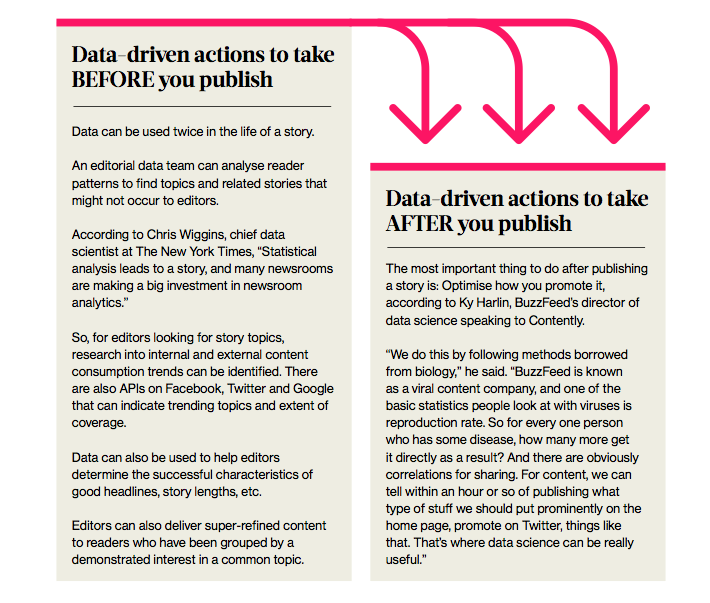
Once the transformation is complete, everything changes. “Now data acts as the guiding light for setting media and marketing services solutions,” said Hanley Wood’s Goldstone. “That has transformed the company dramatically. Where we used to lead with media or trade show sponsorships, now we lead with data. “We hired over 20 people from the tech media space to help build up all our digital platforms and strategic marketing services,” he said.
Data now informs everything at Hanley Wood, from editorial decisions to long-term consultative marketing engagements, website development, lead generation and content marketing. Hanley Wood hasn’t stopped there. Goldstone has branched out into providing data-as-a-service, offering database management services to help clients align customer acquisition, media, marketing, and events strategies.
As a result, Hanley Wood’s customers are “enlisting our talent, our expertise, our specialisation, our data services, and our data to help build more robust databases that they can leverage for marketing purposes,” said Goldstone.
The dominance of data has changed the whole marketing landscape, and is forcing media companies to adapt, according to Silber. “A media company with a strong position and the right skill sets can dominate a market with a much broader portfolio of products, all based on data analysis: Lead generation, lead nurturing, branding solutions, strategic insights, thought leadership, marketing services, research.”
As challenging, and perhaps disturbing, as this might sound, it is actually a good thing: “The good news is that these dynamics have created a new media-company sweet spot,” said Silber. “No one else — not Google, not social media, and not marketers themselves — possess all the skills needed to maximise market engagement and marketing ROI.” Media companies large and small, B2B and consumer, are all moving ahead with data-driven business models, and not content-and-advertising models,” concluded Silber.
The Harvard Business Review Group (HBR) is already there. “We view our subscriber file as just as crucial to the sustainability and growth of the business as our content archive.
And the two really do go hand in hand. We want to understand what motivates our audiences and what they are looking for, and the evolution of the audience — from someone who comes in anonymously to someone who registers and then subscribes. We then want to focus on retention,” HBR Group vice president, marketing Sarah McConville told FIPP.
This is a key adjustment in a publishing company’s vision of itself: “We are becoming a CRM management partner: We’re really an information and services company that has a media companion,” Hanley Wood’s Goldstone said.
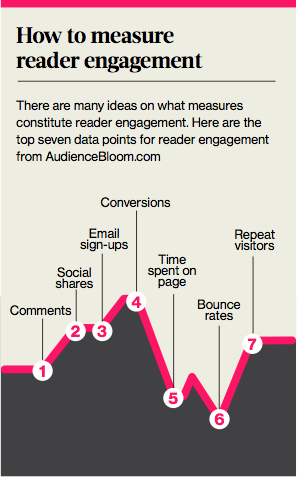
Data and editorial: A symbiotic relationship
Being data-centric does not diminish the power or importance of editorial content. What the data marketers care about is audience, and audiences only happen because they use our media,” Ziff Davis senior vice president of data solutions Bennett Zucke told Folio. “Media is still the core driver of data, but it’s just that the data is offering a brand new revenue opportunity.”
By the same token, data also enables an editorial team to deliver a better and more user-centric experience, according to Condé Nast vice president of growth and data science, Ky Harlin.
Who is in charge of data?
The sudden urgency of mastering the mountains of data is thrusting an entire new class of people into the world of publishing: statisticians. As publishers scramble to make sense of their data, they are stumbling over themselves to hire data scientists to transform all the raw data into strategic and tactical gold.
Mashable went for a Ph.D. in theoretical condensed matter physics as their first chief data scientist. Haile Owusu’s expertise is in the parameterisation and exact solution of integrable matrices. OK, in English, all his academic work involved statistical learning as applied to predictive analytics, hence the a not-so-outlandish jump to media analytics.
Maybe there is some publishing magic in theoretical physics because the New York Times also hired a Ph.D. in theoretical physics as its first chief data scientist in 2014. Chris Wiggins, who was also associate professor of applied mathematics at Columbia University, now leads a small team using machine learning to monitor reader behaviour and analyse what keeps readers coming back, and what doesn’t.
“Subscribers are telling you what they like about the content — you just have to listen,” Wiggins told Digiday.
At News Corp., they also went for a Columbia professor, but not in physics. Dr. Rachel Schutt, holds a Ph.D. in statistics, and two Master’s degrees — one in math from Columbia and one in engineering-economic systems and operations research from Stanford.
Not every publishing company sees the need for a chief data scientist.
At news site Vocativ, there is not a single data expert, but half a dozen analysts from a variety of backgrounds, including law enforcement, NGOs, and private equity, who dig into corners of the web where even Google doesn’t go. They and the four dozen Vocative reporters then use the company’s Open Mind proprietary platform to create stories that no one else can see or, hence, publish.
“We feel it’s the best way to get stories that other people don’t have,” Vocativ managing editor Markham Nolan told Digiday. “By using people who understand data, how to monitor very low-level sources, we can find very unique pieces of content.
“[Of the] last five to ten hires that we’ve made spanning the organisation, almost all of them have some sort of data specialty,” president of Hanley Wood Digital Andrew Reid told Publishing Executive. “We have a team of three people whose sole focus is testing our email templates, day in and day out. Likewise, the last three editorial hires we’ve made have all been SEO specialists… who really understand who’s coming to the site, how they’re engaging, where the entry points are, where the exit points are, what’s working, and what’s not. That’s driving [engagement] much more than the instinctual approach that our editors have historically taken.”
Scripps Networks also did not hire a chief data scientist. !e best way to get the best expertise across so many areas — front-end development, operations, programming language, analytics — is to have a team of specialists, said Scripps Networks Interactive vice president, audience development Laura Evans at the International News Media Association World Congress in New York in 2015.
However a publisher approaches the staffing issue, the data people must not be stereotypes of communication-challenged geeks, but men and women who can reach out to the data-challenged across the company and get them comfortably involved.
Data personnel must be good at building bridges and getting buy-in from colleagues who might initially be threatened by the whole data thing, according to Toronto’s Globe and Mail vice president of data science and audience intelligence Greg Doufas speaking to the International News Media Association World Congress.
“Make sure you hire people who know how to have a conversation with someone else in their own language,” he said.
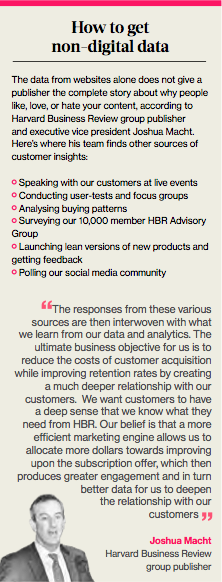
Make the database easy to use and access
Once you’ve got your data team together, they need to decide about ease of use, access, and workflow.
With a unified database touching just about every department in a publishing company, uncertainty or even hostility can surround the question of access and responsibility (read, ownership). Who should own data initiatives? Who should have access to data? Who should be held responsible for building, analysing and deploying it?
“We all know media companies need to be able to combine both o ffline/online data into one central database,” James Capo, vice president of digital business development at B2B publisher Access Intelligence, told Folio. “But the key is creating the operational workflow around the data. The data means nothing if the business units can’t quickly access it and put it into revenue generating opportunities or ideas.”
“The key is to start with the end user of data within the company, the sales or marketing professionals, along with the content creators who adjust what they do as audience engagement data suggests preferences,” said Capo.
And then Capo outlined for Folio his six rules for database success:
1. Ease of use: Any unified database tool needs to be one that is easy to use, one that the business owners want and are willing to use
2. Demos and user testing: these are critical when selecting systems. The data conversation, and more importantly, access to the data, needs to move out of the back office into the hands of the operating groups
3. Instant access by all parties: Sales and marketing shouldn’t have to pick up the phone and ask someone for data they want to use. They should be able to access it at any time and create simple target segments in an intuitive platform on their own.
4. Easy creation of audience segments on the fly: Sales should be able to create audience segments, in real time, while sitting with a client. As they do that, the client will start to ask more engaging questions, and begin to play the “what if” scenario: “What if we change that, or add this?” It quickly becomes a more consultative conversation.
5. Segmentation for marketers: Marketers should be able to create segments that show them which readers/attendees are most engaged on their site, or with email, as well as add demographics filters and then be able to quickly deploy a campaign against that data.
6. Capability to accept “off-line” data: the platform should be able to input “offline” data like print subscriptions or registration data that may not be as dynamic (in terms of changing often like web behaviours) but provides valuable first-party info.

How to decide where to get what data?
So far, so good. Now, where should publishers go to get their data?
Basically, they should look anywhere consumers interact with the publishing company.
“You have to be able to deliver more clear, quantitative, quantifiable insights into the consumer,” the Enthusiast Network (TEN) CEO Scott Dickey told Folio.
So Dickey and TEN have systems, for example, to capture multiple attendee behaviours at live events, plus gathering website analytics from reader behaviour on TEN pages, and then following those readers when they leave to go elsewhere. With TEN videos, Dickey is pushing more content behind a paywall to increase data collection (and, by the way, subscriber revenue).
“We’re very focused, for example, on what content they’re digesting on what car,” Dickey said. “What make and what model — and then sharing that with our OEM [original equipment manufacturer] partners. We’re looking for consumer data points and traits that influence strategies within the channel.”
Other publishers capture data via promotions, contests, white paper downloads, forums, etc. But of all the data a publisher can collect, the most important are the indicators of engagement. That opinion, however, is not shared by everyone. There is still some sentiment for clicks, page views and unique visitors, and there is still a debate over what are truly revealing data.
“What seem like the simplest, most direct metrics for determining success in the digital publishing space — clicks and page views — only tell part of the story,” wrote Chartbeat chief data scientist Josh Schwartz in the company’s 2015 year-end message. “Page views tell you whether a headline was catchy, not whether the content was any good. They tell you if you’ve got a big spike in traffic, but not whether those visitors are coming back. Your goal is not to chase clicks, it’s to grow a loyal, returning audience. That’s where attention comes in. When you measure attention, you measure quality.”
According to the Columbia Journalism Review (CJR), the click is “a poor measure of audience, applying the same value to an attentive reader and a drive-by visitor.”
Chartbeat substantiated that opinion in research that found 55% of all page views get less than 15 seconds of engagement, according to the company. And when visitors are engaged for 15 seconds or more, viewability is 60% compared with just 28% for readers who spend less than 15 seconds with a story.
“Clicks are also easy to fake,” wrote CJR senior editor Alexis Sobel Fitts on cjr.org. “At one point, corrupt marketers hired armies of humans to increase impressions with their mouse, but now the process has been outsourced to robots. These “fraudulent bots” are responsible for about 36% of online traffic, according to data cited by the Interactive Advertising Bureau.”
The problem is that since the beginning of digital advertising, cost per thousand impressions (or CPM) has been the industry standard.
But clicks can be easily bulked up using tricks like clickbait headlines that do not mean readers actually spent time on the page. Some publishers such as Gawker have exacerbated the problem by paying staff based on traffic. The advertising industry’s undying attachment to clicks drove the kind of behaviour one would expect: Deliver clicks at all costs.
One example illustrates the dilemma. When Chartbeat founder Chris Haile asked the web editor of a publishing company about his readers’ interests, the editor replied that he didn’t care “as long as I’m hitting my click numbers,” recounted Haile to CJR. “That just depressed the shit out of me,” Haile said.
So Haile vowed to change things. “We’re in crisis because we chose the wrong metrics,” said Haile. “And that has kind of screwed everything.”
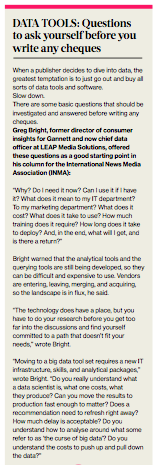
Valuing time spent on site, instead of raw clicks, would transform the internet into a place “where quality makes money and great design is rewarded,” Haile told CJR.
Would shifting the metric to time move the internet and advertisers to better, more intelligent content? Haile believes that the stories people read are of higher quality than those they only click on, an assumption he backed up with data, according to CJR.
Chartbeat researched keywords in 2013 and found that headlines that received the least amount of attention per click included typical clickbait words like “top,” “best,” “biggest,” and “richest”, he told CJR. Words receiving the most attention included “Syria,” “Egypt,” “Obamacare,” “Trayvon,” “Snowden,” and “D.C. 2013”, he said.
“Time is finite for each of us,” said Haile, adding that its very scarcity makes a reader’s “gift” of time a valuable measure for publishers and advertisers alike. “Impressions and clicks are faulty metrics. The only metric that matters — what we in this room are obsessed with — is attention,” New York Times executive vice president of advertising Meredith Kopit Levien told attendees at Social Media Week last year.
If attention is important, engagement is the next level. Engagement can be measured not only by time but also by actions, such as social media sharing, commenting, emailing, etc.
At Mic, a news site for millennials, they focus on three measures: “We track overall sharing, thought-leader engagement on social, and media mentions,” Chris Altchek, Mic CEO, told Digiday. “Putting all three together, we’re able to measure the impact of an individual story. We also track depth of engagement on a story-by-story basis which includes time spend, scroll depth, and how many readers subscribed to Mic after reading a story.”
So let’s look at how smart data can help solve publishing’s problems, starting with editorial:
EDITORIAL: How data can help solve content and audience engagement challenges.
For starters, data scientists are not editors.
Data scientists can gather, analyse, and interpret data, and then make recommendations. But editors must bring their experience and instincts to bear on choosing strategies and tactics based on data.
“A critical skill is for editors to synthesise their gut instinct about what makes great journalism with the signals that they hear from the audiences,” New York Times director of analytics innovation James G. Robinson told World News Media Congress delegates.
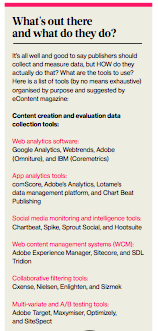
Beyond time and engagement, both of which indicate reader interest in the topic, editors should look at what drove readers to the story (headlines, social promotion, video, email newsletters, distributed content, etc.), and try to draw replicable lessons. There are lots of tools to help editors act on the lessons of data. Chartbeat’s newest editorial tool — Engaged Headline Testing — is the first multivariate testing tool built specifically for media sites, according to the company.
It is the first tool that optimises for the behaviour after the click, the company said. For a headline to win in this test, it must be both enticing enough to attract traffic, but also, and more importantly, compelling enough to keep an audience on the page. “Not only does this optimise for audience engagement rather than page loads, it also enables editorial teams to directly affect the overall ad viewability performance of their site with winning headlines garnering more time on the page,” said Haile.
And, when quality editorial wins, advertising wins. “In fact, we’ve found that by optimising for clicks that result in more engaged time on a page — or ‘Quality Clicks’, as we call them — it means more ads are seen for longer,” said Haile.
Mashable has a proprietary predictive analytics tool, Velocity, which monitors how stories are shared and interacted with across social networks. Because it can predict with an impressive degree of certainty which stories will be popular on social media, Mashable editors “like to think of it as a digital crystal ball,” Mashable’s global news editor Louise Roug wrote on journalism.co.uk.
At Ozy Media, “our most important metric is the number of people who are coming to the site by habit,” Aneesh Raman, Ozy vice president of marketing and audience development, told Digiday. “It’s important to us to have people who know what Ozy is but also know what it’s all about. Our core metric is repeat visits.”
Refinery29, a digital-only site focused on millennial women, has used reader behavioural data to influence content decisions and social media promotion. The result has been a 163% annual growth in unique visitors, the company’s director of data and analytics Irene Lee told the International News Media Association Congress. For example, Refinery29 was able to convert Sundays from the worst traffic day to often its best, Lee said.
Refinery29 also used the data from email testing and A/B testing of headlines to achieve an almost 40% increase in email click-through rates and almost 50% increase in story click-throughs, Lee said.
Refinery29 also uses reader data to boost under performing stories with new headlines and launch new content categories that data indicates would attract readers. Sometimes, the data points to design changes that can enhance content performance.
When BuzzFeed publisher Dao Nguyen was head of data and growth, she observed that not only did mobile devices count for more than 50% of the site’s tra ffic, but also that after Facebook, the second most common sharing method was email. Given how difficult it was to share via email on the BuzzFeed mobile site, Nguyen thought tra ffic might grow if they made their mobile share button more visible, accessible and easy to use. Sure enough, within a week, email shares rose 100%, according to Nguyen.

How can data help attract new readers, get them to return, and convert them to subscribers.
Data can identify the kind of content that brings readers back, as well as the readers who actually do come back, and then can target those readers with personal subscription appeals based on their interests.
“Looking specifically at subscribers and product purchasers, data and analytics have been integral to our goal of lowering the cost of acquisition while increasing retention,” Sarah McConville, vice president of marketing at Harvard Business Review (HBR) Group and publisher of Harvard Business Review Press told FIPP.
“It is essential that we think about the life cycle of our audience all the way through so that we continue to deliver what our subscribers find valuable which in turn, increases the lifetime value of our subscribers,“ she said. “This would be impossible without data and analytics.”
Slate, too, is looking for help from data analysis to identify the kind of content that will get readers to open their wallets. “What should we be thinking about? What’s resonating with people so much that they’re willing to pay for it?
Those are some of the examples that are really compelling in forming the broader strategy of the company,” Slate general manager Brendan Monaghan told Publishing Executive.
Marketing campaign results can identify which approaches produce the best results, and at the same time, bring to the surface potential new audiences for new products. Publishers can also entice readers to subscribe by automatically synching the data from their website behaviour with email lists by topic preferences, products purchased, and articles viewed to deliver targeted, personalised enewsletters, according to EPublishing.com’s Danielle Lattuga.
ADVERTISING: How can data help deliver more elective advertising?
If the “attention web” is good for content, it follows that time spent would be good for advertising as well. Last year, the Financial Times launched a “cost per hour” (CPH) metric. With digital advertising beset by low viewability scores and fraud, marketers are demanding better measurement and transparency to show actual outcomes.
Th old cost per thousand (CPM) system values every impression the same; cost per hour (CPH), on the other hand, values impressions by time. Extensive testing found that brand familiarity and recollection increases significantly the longer an ad is in view, according to the FT. Ads seen for five seconds or more on FT.com show up to 50% cent higher brand recall and familiarity than ads that are visible for a shorter period of time, according to the company.
Th new FT CPH system can also ensure 100% viewability of five seconds or more for advertisers. The Financial Times touts the benefits of using time data to charge for advertising as follows:
• Guaranteed reach: The CPH system offers blocks of audience time to advertisers with the guarantee that the client will only be charged for ads that are seen for more than five seconds of “active time” with 100% viewability
• Demonstrable impact: Readers who see an ad for five seconds or more are up to 50% more likely to display familiarity and association with a brand
• Hyper-targeted campaigns: Using the FT’s detailed subscriber data, advertisers can run highly targeted campaigns reaching qualified audiences
Service provider Visu (acquired in 2012 by Nielsen) also uses data to provide campaign measurement and optimisation solutions in real time so advertisers can quickly and cost effectively improve the performance of their campaigns. Acting on real time data increases effective media spend and maximises the value of the advertiser’s investment. Vizu uses a web poll asking each consumer sampled to measure how the campaign performed against its primary objective, resulting in real-time performance assessment. The poll targets creative, targeting, and frequency which, taken together, allow advertisers to improve campaign performance in mid-stream. Another service provider in the ad effectiveness space, comScore, also has a tool to help advertisers use data to determine the factors for success and failure in digital advertising.
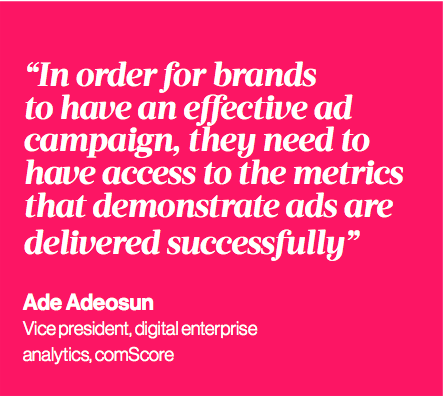
“In order for brands to have an effective ad campaign, they need to have access to the metrics that demonstrate ads are delivered successfully,” said comScore vice resident, digital enterprise analytics Ade Adeosun. “While these metrics are currently available, gathering all of these metrics that live in disparate places to create actionable insights is very labour intensive for brands.
“Simply having the data for each of the stages of a campaign life cycle in one platform makes these insights easier to be applied to campaigns in-flight and in the future,” said Adeosun. “Now with comScore Digital Analytix®, brands are able to collect all these metrics in a single place, which makes assessing performance both easier and faster… [identifying] what is and isn’t working to improve their digital campaigns.”
And yet another data analytics provider, Quantcast, enables publishers to deliver qualified audiences for targeted advertising. For example, Quantcast helps BuzzFeed measure the audiences of sponsored posts. Using thousands of custom segments in “Quantcast Measure”, BuzzFeed can track the audience engaged by each post.
So, when an advertiser requests a target audience, such as 35-54-year-olds, BuzzFeed can show example posts that engaged that profile, according to Quantcast. Thus, the data enables advertiser to both target audiences and choose types of sponsored content that has proven to attract those target audiences.
Finally, Chartbeat is using data to create an ad delivery system that mimics television. “With ‘Engaged Ad Refresh’, publishers borrow an idea from TV and make money from the amount of engagement they can capture vs. the amount of pages that load,” wrote Chartbeat’s Tony Haile on the company’s blog. “Chartbeat tracks the attention of each user as they interact with ads and content, and after an ad has received a set amount of ‘Active Exposure Time’, it identifies and serves the next best ad for that user. It’s making the web less like magazines and more like TV, where four 30-second commercials will run in a two minute break.
“For the advertiser looking beyond viewability, an ad refreshed after 30 seconds of active exposure has received 30 times the attention required by the viewability standard,” said Haile.
“For the publisher with engaging content, it significantly increases the amount of viewable inventory and makes the quality of the content directly affect the revenue opportunity of the page. In essence, we’re seeing the rise of the digital 30-second spot.”
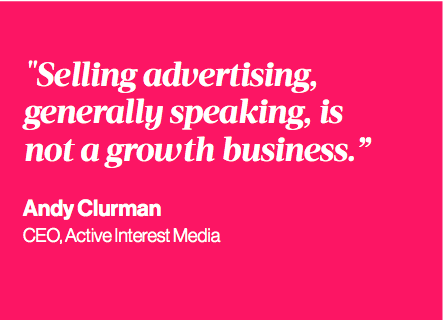
But is all this data mashing working for publishers?
Early reports indicate that the publishers who are executing data consolidation well — i.e., those using a Data Management Platform (DMP) to enhance and scale first-party data assets by combining them with third-party data and making those audiences available in real-time — are already seeing the rewards with CPM increases of over 100% in some cases, according to Zuzanna Gierlinska, director of data management platforms for Oracle Marketing Cloud.
To offer advertisers large groups of targeted audiences, some publishers have begun creating alliances, even with former competitors.
In the UK, for example, The Guardian, Financial Times, CNN International, The Economist, and Reuters last year created the Pangaea alliance, pooling reader data from their combined audience of 110 million to attract advertisers with more compelling targeting.
Also in early 2015, the UK-based Association of Online Publishers (AOP) announced a data alliance of their own called Symmachia (the ancient Greek word for alliance). Symmachia, finally launched in January 2016, combines the audiences of seven premium UK publishers including: Auto Trader, Dennis Publishing, Telegraph Media Group, plus Time Inc.
Other European publishers are reported to be in discussions to create similar alliances to compete with the likes of Google and Facebook. The devil in this alliance-based solution is in the details. The disparate databases, spread across different database systems using different sources, must be consolidated and shared in a way that provides meaningful, actionable data for advertisers.
BEYOND ADVERTISING
“Selling advertising, generally speaking, is not s not a growth business.” Active Interest CEO Andy Clurman told Folio.
Data-related products and services is a growth business.
“Having depth of content, and databases and custom-content solutions in large vertical markets is a great growth strategy,” Northstar Travel Media CEO Tom Kemp told Folio. “You don’t get rid of your media brands, but clearly the growth is not going to come from that.”
All these trends converge at the database. “We have the audience, so we can do research to understand where a brand fits,” Active Interest Media (AIM) CEO Andy Clurman told Folio. “A lot of companies have advanced unified databases… the price has come down and the sophistication has grown exponentially.
“So when an advertiser asks, AIM can demonstrate knowledge of who goes to AIM events, what they like on AIM websites, and with that, make recommendations for types of content that will resonate, for marketing campaigns, for finding lapsed customers, and lots more,” Clurman said. “We’re going to all this from merely amassing an audience and selling ad products against that audience.
”You have to do this, because that’s where the money is going with marketing budgets. “We expect that within two years, a little less than half of all our existing clients will have some sort of marketing-services relationship with us. And by doing that, we expect to grow revenue by about 20% over a two-to three-year period,” he said. “That would have a profound effect on our business.”
Bottom line: It’s time to take your data seriously. The potential is huge, and the downside of not doing so is franchise-threatening.

This article is one of many chapters published in our Innovation in Magazine Media 2016-2017 World Report.


